Trees Birds Mammals Fish Amphibians Reptiles
Wild Algarve
Bookshop
Hypholoma lateritium (Schaeff.) P. Kumm. - Brick Tuft
Phylum: Basidiomycota - Class: Agaricomycetes - Order: Agaricales - Family: Strophariaceae
Distribution - Taxonomic History - Etymology - Toxicity - Identification - Reference Sources
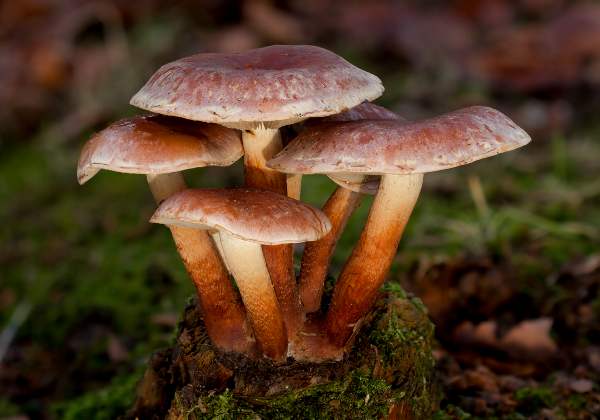
If it were not for the striking brick-red colour and large size of the caps, these rather uncommon wood-rotting fungi might easily be passed by, for they are in other respects similar to Sulphur Tufts and several other common tuft-forming woodland species.
Brick Tufts are much redder than Sulphur Tufts (Hypholoma fasciculare) and when fully developed they are very much larger than the orange Conifer Tufts (H. capnoides),
Distribution
in Britain and Ireland the Brick cap is unfortunately less common than its less flamboyant close relatives, but this speces is widely distributed throughout Britain and Ireland. Brick Caps occur throughout most of mainland Europe and are also recorded in the USA and Japan.
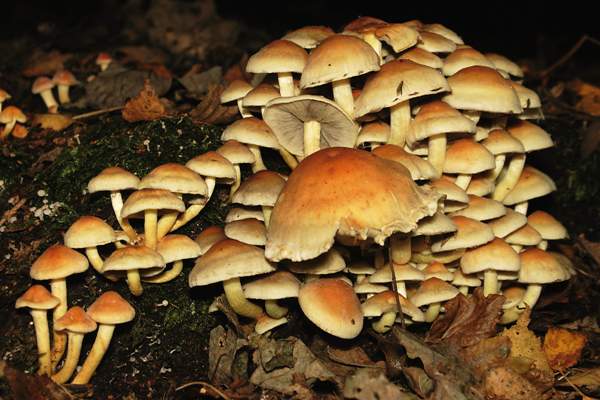
Taxonomic history
When Jacob Christian Schaeffer described this species in 1762 he named it Agaricus lateritius. (Most gilled mushrooms were initially placed in the genus Agaricus in the early days on fungal taxonomy.) More than a century later, in his Der Führer in die Pilzkunde, published in 1871, Paul Kummer transferred this species to its current genus Hypholoma.
Synonyms of Hypholoma lateritium include Agaricus lateritius Schaeff., Agaricus sublateritius Schaeff., Agaricus pomposus Bolton, Pratella lateritia (Schaeff.) Gray, Deconica squamosa Cooke, Hypholoma sublateritium (Schaeff.) Quél., and Naematoloma sublateritium (Schaeff.) P. Karst.
In the USA most mycologists tend to favour the name Hypholoma sublateritium (Schaeff.) Quél.
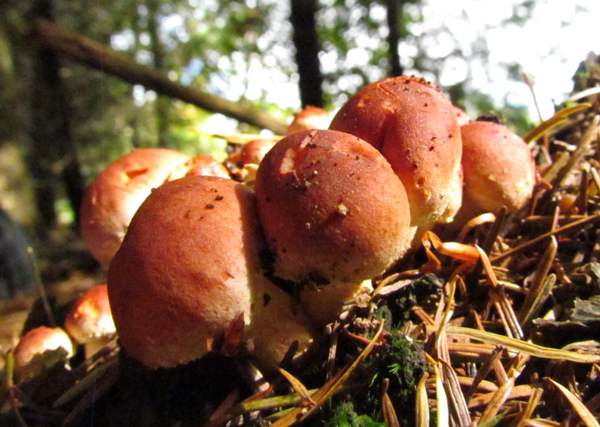
Etymology
Hypholoma, the genus name, means 'mushrooms with threads'. This may be a reference to the thread-like partial veil that connects the cap rim to the stem, covering the gills of young fruitbodies, although some authorities suggest that it is a reference to the thread-like rhizomorphs (root-like bundles of mycelial hyphae) that radiate from the stem base.
The specific epithet lateritium and its synonymous epithet sublateritium deserve some explanation. Sub simply means almost, so that bit is easy; laterit- means brick coloured, but because bricks can be virtually any colour this is hardly the most descriptive name in the kingdom of fungi; however, the caps probably do match quite closely most people's idea of 'brick red'. The currently accepted specific name lateritium more than fits the bill, therefore.
Toxicity
There is some controversy over the edibility of this wood-rotting fungus. Field guides published in Britain generally refer to Brick Caps as inedible. In North America, however, some authorities state that these are good edible fungi if picked young while other report them as suspect or inedible.
Identification guide
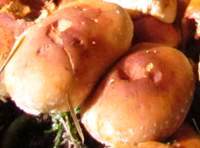 |
Cap
4 to 9cm across, convex, flattening out at maturity but retaining a shallow umbo; the inrolled margins of young Brick Caps are covered with woolly remnants of the partial veil; caps are brick red in centre and paler towards the margin.
As with most tufted (fasciculate) mushrooms, the caps of Hypholoma lateritium are often distorted from the neat circular form of solitary specimens. |
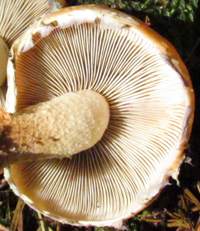 |
Gills
Adnate; crowded; initially cream, the gills of Brick Tuft fungi turn olive-grey and then purplish brown as the spores mature. |
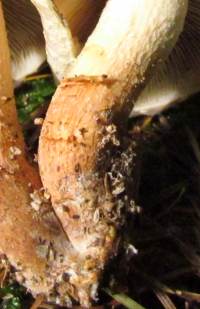 |
Stem
5 to 10cm long and 0.6 to 1.5cm in diameter, the stems of Hypholoma lateritium are fibrous; light ochre at apex, darkening progressively to a reddish-brown base; a faint ring zone is usually discernable. |
 |
Spores
Ellipsoidal, smooth, 6-8 x 3-4.5μm; with a small germ pore.
Spore print
Purple-brown. |
Odour/taste |
No significant odour; the taste can be either mild or bitter and so is not a help in identification. If you do decide to taste these fungi, please don't swallow: they are considered inedible by most authorities and if eaten may possibly cause stomach upsets. |
Habitat & Ecological role |
Saprobic, in small tufts or occasionally singly on hardwood stumps, particularly oaks, and
on buried or exposed roots of dead hardwood trees. |
Season |
July to October in Britain and Ireland. |
Similar species |
Hypholoma capnoides, commonly referred to as Conifer Tuft, is usually smaller and grows on conifer stumps; it is much more common than the Brick Tuft. |
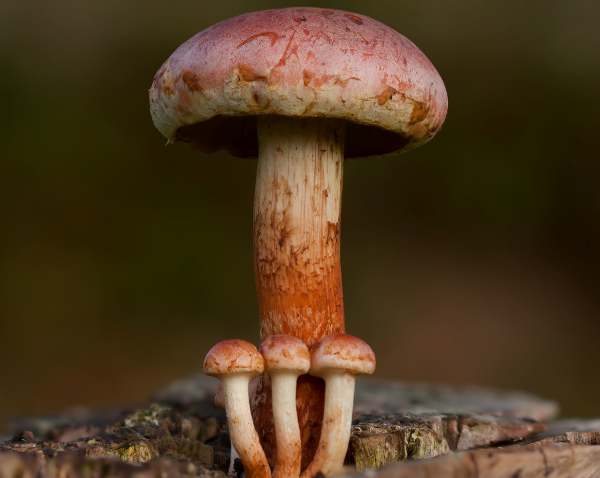
Reference Sources
Fascinated by Fungi, 2nd Edition, Pat O'Reilly 2016, reprinted by Coch-y-bonddu Books in 2022.
Dictionary of the Fungi; Paul M. Kirk, Paul F. Cannon, David W. Minter and J. A. Stalpers; CABI, 2008
BMS List of English Names for Fungi
Taxonomic history and synonym information on these pages is drawn from many sources but in particular from the British Mycological Society's GB Checklist of Fungi.
Acknowledgements
This page includes pictures kindly contributed by David Kelly.
Top of page...
Fascinated by Fungi. Back by popular demand, Pat O'Reilly's best-selling 450-page hardback book is available now. The latest second edition was republished with a sparkling new cover design in September 2022 by Coch-y-Bonddu Books. Full details and copies are available from the publisher's online bookshop...